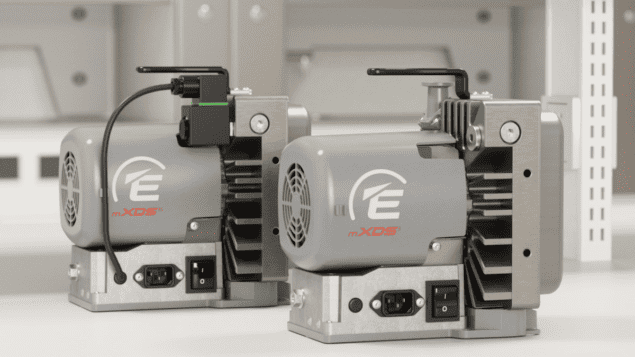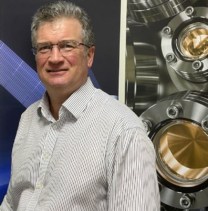With the launch of its compact mXDS3 and mXDS3s series, Edwards is offering scientific and industrial customers greater choice when it comes to the functionality and performance of its dry scroll vacuum pumps

Think small, win big. That mantra has, for some time, proved itself a reliable frame of reference for the vacuum specialist Edwards which, as part of a much broader product development roadmap, manufactures a portfolio of small vacuum pumps tailor-made for analytical instrumentation OEMs (to be integrated within their electron microscopy and mass spectrometry systems), high-energy physics laboratories (for deployment in accelerator beamlines and high-power laser systems), and a range of R&D and light industrial applications (including thin-film coating systems, surface-science instrumentation and leak detection).
Zoom in a little and that Edwards small-pump offering has, until now, spanned the EM and RV range of oil-sealed rotary-vane pumps (0.7–12 m3/h pumping speed); the XDD1 diaphragm pump (1.4 m3/h); and nXDSi dry scroll pumps (6–20 m3/h). Herein lies the opportunity. “We identified a gap in the scroll-pump product family and, on the back of that, a way to provide more choice, more options for our customers,” explains Dave Goodwin, Edwards’ product manager for scroll and rotary vane pumps. “The aim was to develop a compact pump with lower pumping speed than the nXDSi, enhanced performance versus the XDD1, while providing a dry alternative to our small, oil-sealed rotary-vane pumps.”
Fast-forward and that performance gap has now been filled, with the latest additions to the Edwards range of dry scroll pumps – the mXDS3 and mXDS3s – delivering a pumping speed of 3 m3/h together with an ultimate pressure of 0.1 mbar. The configured mXDS3s version (at 8 kg) comes factory-fitted with an inlet valve featuring delay opening (and is also supplied with an exhaust silencer), while the mXDS3 (7.8 kg) provides the standard pump option (with no inlet valve fitted). In the former, the inlet valve offers protection to the vacuum system when the pump is stopped (or stops due to a power failure) by preventing partially compressed gas from re-expanding through the pump inlet. “This is about additional peace of mind for the user,” says Goodwin. “The delayed opening means that when power is restored the valve does not open before the pump is up to full operating performance.”
Both versions of the pump have the same compact footprint (223x158x231 mm) and feature an IEC connector for mains supply, an on/off switch for easy control, plus nominal rotational speed of 3000 rpm (50 Hz) and 3600 rpm (60 Hz). “The mXDS3 and mXDS3s deliver a lot of pumping density – ideal for backing turbomolecular pumps working in the medium- and high-vacuum regime,” notes Goodwin. “They’re also great for instrumentation OEMs, small vacuum-system builders in academic laboratories, as well as industry end-users.”
Collaborative innovation
Operational benefits notwithstanding, it’s evident that the Edwards approach to product innovation is rooted firmly in a continuous-improvement mindset and ongoing dialogue with the company’s diverse customer base. “We’re systematic about taking inputs on board from our end-users,” explains Goodwin. “In this way, we endeavour to solve their problems by adapting existing products or developing new ones.”

At the heart of that collective conversation is Edwards’ Global Technology Centre (GTC) in Burgess Hill, UK. As part of Edwards’ international R&D effort, the GTC employs a team of scientists and engineers dedicated to core technology development and validation across all of the company’s product lines, including the small-pump portfolio. Their goal: to bring through the right products, features and functionality to market – at the right time – to align with customers’ evolving vacuum requirements.
When developing the mXDS3 and mXDS3s, the first task for Goodwin and the cross-functional GTC project team – comprising fellow product managers, applications specialists and business line managers – was to work up a preliminary market requirement specification and an early-stage technology demonstrator. “We subsequently placed the demonstrators into a range of customer settings – academic, industry, OEM – to see if we had a viable product concept to push through to full commercial launch,” he notes.
The customer feedback confirmed that the Edwards team was heading in the right direction and, what’s more, underpinned a granular technical requirements-gathering exercise to fine-tune the product functionality. “At which point,” adds Goodwin, “all of the relevant learning and domain knowledge from the GTC was transferred to our manufacturing hub in Lutin, Czech Republic, for iteration of the pump design into a market-ready product and prelaunch ‘road-testing’ at selected customers.”
Making life easier for the customer
While the commercial positioning, for the most part, emphasizes compact footprint, lightweight design and pumping speed, Edwards is keen to highlight additional operational upsides of the mXDS3/mXDS3s platform. For starters, these are dry pumps, so there’s no oil for the user to check, top up or replace (as per oil-sealed rotary-vane pumps). That environmental win also translates into lower maintenance overhead and less intervention, with the user typically only required to change the tip-seal between the pump’s fixed and rotating scrolls every two years (versus two or three oil changes a year for a rotary-vane pump).
Other significant features include the helium pumping performance (which is similar to that for air and with no “memory effect”); low noise level – specified at 54.0±2.5 dB (A) – to ensure a better-quality working environment when the pump is running at ultimate vacuum; and the flexibility of being able to mount the pump horizontally (as standard) or vertically (with the motor on top) when integrating within an existing vacuum system.
“The mXDS3 and mXDS3s reinforce the breadth and depth of Edwards’ scroll-pump offering,” concludes Goodwin. “What’s more, these products showcase our unmatched application knowledge and technical expertise when it comes to design, improvement and innovation across the small-pump portfolio.”
- SEO Powered Content & PR Distribution. Get Amplified Today.
- PlatoData.Network Vertical Generative Ai. Empower Yourself. Access Here.
- PlatoAiStream. Web3 Intelligence. Knowledge Amplified. Access Here.
- PlatoESG. Automotive / EVs, Carbon, CleanTech, Energy, Environment, Solar, Waste Management. Access Here.
- BlockOffsets. Modernizing Environmental Offset Ownership. Access Here.
- Source: https://physicsworld.com/a/dry-scroll-pumps-filling-the-performance-gap/
- :has
- :is
- :not
- $UP
- 1
- 60
- 7
- a
- Able
- About
- academic
- accelerator
- across
- Additional
- additions
- Adds
- aim
- AIR
- align
- All
- also
- alternative
- an
- Analytical
- and
- Application
- applications
- approach
- ARE
- AS
- At
- back
- backing
- base
- BE
- been
- before
- being
- benefits
- between
- Big
- board
- breadth
- bring
- broader
- builders
- business
- by
- centre
- change
- Changes
- check
- choice
- click
- Collective
- comes
- commercial
- Company’s
- comprising
- concept
- configured
- CONFIRMED
- control
- Conversation
- Core
- customer
- Customers
- czech republic
- Dave
- dedicated
- delay
- Delayed
- deliver
- delivering
- deployment
- depth
- Design
- Detection
- develop
- developing
- Development
- dialogue
- direction
- diverse
- does
- domain
- dry
- due
- early stage
- easier
- easy
- effort
- emphasizes
- employs
- Engineers
- enhanced
- ensure
- Environment
- environmental
- Every
- evident
- evolving
- Exercise
- existing
- expertise
- Explains
- Failure
- family
- Feature
- Features
- Featuring
- feedback
- fellow
- filled
- filling
- firmly
- First
- fixed
- Flexibility
- Footprint
- For
- Former
- FRAME
- from
- full
- functionality
- gap
- GAS
- Global
- goal
- great
- greater
- had
- Have
- he
- Heading
- Heart
- helium
- Highlight
- horizontally
- HTTPS
- Hub
- ideal
- identified
- if
- image
- improvement
- in
- include
- Including
- industrial
- industry
- information
- Innovation
- inputs
- integrated
- Integrating
- International
- intervention
- into
- issue
- IT
- iteration
- ITS
- itself
- jpg
- Keen
- knowledge
- laser
- latest
- launch
- leak
- learning
- less
- Level
- lies
- Life
- light
- lightweight
- Line
- lines
- little
- Lot
- Low
- lower
- maintenance
- manager
- Managers
- Mantra
- manufacturing
- Market
- Mass
- max-width
- means
- Microscopy
- mind
- Mindset
- more
- most
- Motor
- MOUNT
- much
- New
- no
- Noise
- Notes
- now
- of
- offering
- Offers
- Oil
- on
- ones
- ongoing
- only
- open
- opening
- operating
- operational
- Opportunity
- Option
- Options
- or
- our
- part
- peace
- performance
- Physics
- Physics World
- platform
- plato
- Plato Data Intelligence
- PlatoData
- plus
- Point
- portfolio
- positioning
- power
- pressure
- preventing
- problems
- Product
- product development
- product manager
- Products
- project
- protection
- proved
- provide
- provides
- providing
- pump
- pumping
- pumps
- Push
- R&D
- range
- regime
- reinforce
- relevant
- reliable
- replace
- Republic
- required
- requirement
- Requirements
- right
- roadmap
- running
- same
- says
- scientific
- scientists
- scroll
- see
- selected
- Series
- settings
- showcase
- significant
- similar
- small
- So
- SOLVE
- some
- specialist
- specialists
- specification
- specified
- speed
- Sponsored
- standard
- stopped
- Stops
- Subsequently
- supplied
- supply
- Switch
- system
- Systems
- taking
- Task
- team
- Technical
- Technology
- Technology Development
- than
- that
- The
- their
- These
- this
- three
- Through
- thumbnail
- time
- to
- together
- top
- transferred
- two
- typically
- Uk
- ultimate
- underpinned
- unmatched
- until
- User
- Vacuum
- validation
- valve
- version
- Versus
- vertically
- viable
- was
- Way..
- we
- WELL
- when
- which
- while
- win
- with
- within
- Work
- working
- world
- year
- years
- zephyrnet













